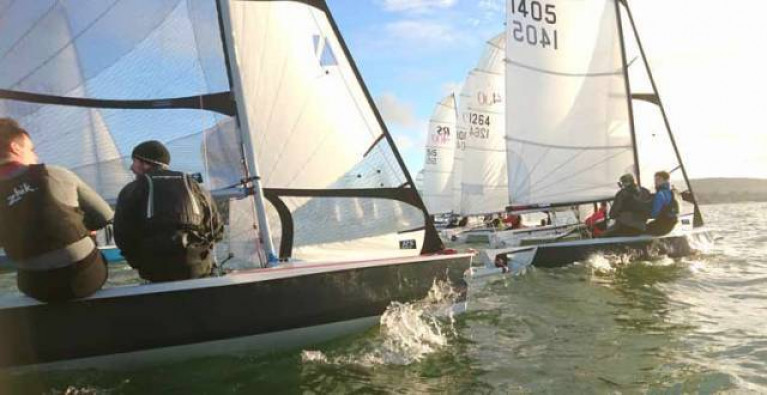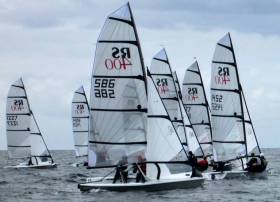Displaying items by tag: RS200
The RS400 and RS200 Eastern championships were held at Greystones Harbour Sailing Club, and it was a thrilling day for the 24 RS 400s and other boats that participated. The Simon Herriot Memorial trophy was also incorporated into the event, adding an extra layer of significance to the competition.
The first race was marked by several lead changes between Galligan/Zack and the current national champions, Andy Verso and Tom Moran. Race two was intense as a strong gust of wind came in off the land pre-start. Rumball and Sam Hunt took first place in this race, making it their moment to shine.
In race three, Dara McDonagh and Trish Clancy claimed the victory, making it a different winner in each race. It all came down to the final race to decide the overall winner. Galligan and Zack tried to port tack the fleet off the start line but didn't quite pull it off. However, they managed to do some damage limitation and rounded the top mark first. After holding off the fleet, Galligan emerged as the winner and claimed the Eastern Trophy and the coveted Simon Herriot Memorial Trophy.
 Kenny Rumball and Sam Hunt were presented with second prize at the RS400 Eastern championships at Greystones Sailing Club by Commodore, Kieran O'Byrne
Kenny Rumball and Sam Hunt were presented with second prize at the RS400 Eastern championships at Greystones Sailing Club by Commodore, Kieran O'Byrne
 Andy Verso and Tom Moran were presented with third prize at the RS400 Eastern championships at Greystones Sailing Club by Commodore, Kieran O'Byrne
Andy Verso and Tom Moran were presented with third prize at the RS400 Eastern championships at Greystones Sailing Club by Commodore, Kieran O'Byrne
 The RS400 Masters winners were Canice Keane and Peter Dolan and were presented with their prize at the Eastern championships at Greystones Sailing Club by Commodore, Kieran O'Byrne
The RS400 Masters winners were Canice Keane and Peter Dolan and were presented with their prize at the Eastern championships at Greystones Sailing Club by Commodore, Kieran O'Byrne
GCSC's Alex and Martin Roe Crowned Champions at RS 200 Easterns
The RS 200 Easterns saw twelve top-class sailors take to the water, including seven junior and four lady helms. The event, held on a flat sea with gusty offshore breeze of up to 25 knots, saw the competition on the water get intense as a three-boat fleet from Greystones was joined by visiting boats from Galway Bay, Cullaun, Killaloe, and Wicklow.
Despite the gusts coming through the downwind causing many a capsize and flat-out hiking on the upwind, the pace of racing was electric. GCSC's son/father duo Alex and Martin Roe ultimately took home the top honours, with a 1st, 3rd, 2nd, and a final 1st in the fourth race.
Wicklow SC's Alex Costello and Charles Heather came in second place, with third place going to Greystones juniors - and twins - Cian and Caoimhe Swan. The RS200 fleet has been building over the last few years, with juniors feeding in from the Feva fleet.
PY Dinghy Sailors Brave Stiff Winds
The Greystones Sailing Club (GSC) held a sailing event last weekend, but unfortunately, none of the expected two-man boats showed up. The PY fleet, consisting of an Aero 6 and 11 ILCAs, sailed singlehandedly with 6 and 4-foot rigs. Despite the strong offshore winds and a forecast that may have deterred other sailors, the fleet launched after the beach master gave the signal.
The races were turned around quickly by the Race Officer (RO), Michael Conway, who had to abandon several races during the starting sequence and move the windward mark several times throughout the day. The wind fluctuated in strength, with the local keelboat fleet recording a gust of 28 knots at one stage.
 RS Aero sailor Roy Van Maanen receives his PY prize from Greystones Sailing Club Commodore, Kieran O'Byrne
RS Aero sailor Roy Van Maanen receives his PY prize from Greystones Sailing Club Commodore, Kieran O'Byrne
Several boats capsized, and one broke its mast during the races, but the sailors remained undaunted. The conditions favoured the Aero 6, sailed by Roy Van Maanen, who outperformed the ILCA 6's. Matthew Lawless, Donal Walsh, and Gareth Giles posed formidable challenges, with the lead positions changing constantly.
After an exhausting day of sailing, the fleet returned ashore to enjoy a BBQ and hospitality at the GSC.
All in all, it was a successful event that showcased the sailors' resilience and determination in the face of challenging conditions.
Blessington Sailing Club Hosts Inaugural RS Fest Incorporating RS200 and RS400 National Championships
Blessington Sailing Club hosted the RS400s, 200s & Fevas for a very breezy weekend of racing incorporating all three fleets’ National Championships and the inaugural RS Fest. Blessington was, as ever, a very welcoming and accessible club on Friday morning. Plenty of space available for cars, campers, trailers and rigging of boats. Scones, pastries, tea and coffee are laid out for everyone in the busy club room. Entries were very strong for the event, with 25 RS 400s, 5 RS 200s and 25 RS Fevas, who are continuing their development streak!
 Blessington Sailing Club hosted the RS400s, 200s & Fevas for a very breezy weekend of racing incorporating all three fleets’ National Championships and the inaugural RS Fest
Blessington Sailing Club hosted the RS400s, 200s & Fevas for a very breezy weekend of racing incorporating all three fleets’ National Championships and the inaugural RS Fest
Strong winds and dark streaks on the lake promised fun racing for the first day of racing on Friday…. and so it was. After a brief delay, the 400 and 200 fleets kicked off with the first few races. Awesome downwind legs after such an extended period of light airs across the country were such a breath of fresh air (excuse the pun). By the end of the day, Michael Tyrell and team had already put away three races of the 9 scheduled for both fleets.
 RS Fest Committee Vessel
RS Fest Committee Vessel
Leading the 400s after Day 1 was Marty O’Leary & Conor Kinsella (Greystones SC) with three 2nd places, despite hitting the front in each race. Wins were spread out between Peter Kennedy/Stephen Kane (RNIYC, SLYC), Andy Verso & Tom Moran (Greystones SC) and Luke/Erin McIlwaine (Newcastle YC/CSC).
 RS400s on Blessington lake
RS400s on Blessington lake
In the 200s, Jocelyn & Emily Hill from CASC set the pace with three convincing wins, a dominant performance that they would continue across the weekend.
Plenty of gear damage across the fleet caused a scramble on Saturday morning to fix rivets and glue slot gaskets in time for racing. Winds were stronger still and building; meaning champagne sailing for some, and lukewarm lake-baths for others. With one race completed and one boat dis-masted, racing was postponed ashore to see if it would moderate.
Sarah Dwyer who was sailing in her RS200 was delighted to be back in the boat; ‘What a weekend to get back in the RS200 after a two-year absence! My crew, Flore, had a blast, a baptism of fire. The disconcerting bend in the bowsprit as the bow and much of the centreboard left the water had the adrenalin pumping, particularly as we held off a few 400s! We couldn’t touch Jocelyn and Emily Hill all weekend, but even that didn’t dampen the on-the-water fun. Congratulations to them both on a well-deserved gold. I love the Aero, and I’m sure it too, would have hit a few record speeds, but it’s great craic to share the experience. Big thanks to all the friendly volunteers in Blessington, also to Michael & Therese Tyrell, David Mullally and our friendly RS dealer, Kenny Rumball!’
"Entries were very strong for the event, with 25 RS 400s, 5 RS 200s and 25 RS Fevas"
Day two was a little breezier. With Fevas now also on the water in a strengthening breeze, race 1 gradually became an obstacle course downwind, trying to locate a good spot to gybe.
 A dismasting in the breezy conditions
A dismasting in the breezy conditions
A few key 400 breakages ( a mast and a rudder) and some lesser issues, assured sailors that going ashore was indeed a good call. We waited for a possible abatement but it didn’t happen and we retired for the evening due to the regular 30-knot gusts.
Verso/Moran crept into the lead by 1 point in the 400s ahead of both Kennedy/Kane & O’Leary/Kinsella. Blessington, superb hosts throughout, kindly arranged to bus the visitors down to The Avon resort for an evening out by the lake. Uncle Liam kindly hosted an after-party with a firepit back at the club’s campsite into the small hours.
Weary heads popping out of tents were greeted by a comically wet and calm Sunday morning, with an early start time in the hopes of making up for the missed races on Saturday. Unfortunately, the lake had other ideas, providing a 90-degree shift that forced the abandonment of race 5, and a long delay until the wind settled. Two more races were squeezed in, which ended dramatically with thunder and lightning on the final beat, and 40 knots of wind as boats approached the finish. A graveyard of capsized hulls littered the gate and finish line while the squall blew through.
Verso/Moran did just enough to seal first place overall, while the McIlwaines leapfrogged from 4th to 2nd with a 1,2 on the final day. Chris Helme & Alan Claffey won the biblical final race, having led the abandoned race earlier. O’Leary/Kinsella ended with 3rd overall, a capsize on the last drop ending their chance of claiming second after overtaking ten boats on the final frenzied leg. Liam Donnelly claimed the Masters prize with 4th overall.
Day three, the Fevas needed another race to complete a series. As the wind was already shifting right, the team set up a course that by the first DW leg was already well skewed with all 400s and 200s coming to the left gate together, so the race was wisely abandoned on the second lap and the breeze then vanished…
 RS Fevas waiting for wind on Blessington Lake
RS Fevas waiting for wind on Blessington Lake
A few hours of waiting and finally two races were run with an ominous grey cloud formation looming to windward, which managed to reach us with a bang and 40 knots at the end of the second race, again flattening many on the water and allowing some in the 400s to make huge gains in the final race of the weekend.
 RS400 National Champion Andy Verso Tom Moran with Irish RS agent Kenny Rumball
RS400 National Champion Andy Verso Tom Moran with Irish RS agent Kenny Rumball
The Fevas had three races completed, the RS200s and 400s had 6.
 RS Fest, RS Feva Gold Fleet winners - Jessica Daley Young Sally Nixon with Kenny Rumball
RS Fest, RS Feva Gold Fleet winners - Jessica Daley Young Sally Nixon with Kenny Rumball
Bedraggled, dripping and exhausted sailors made it back ashore to pack up and eat!
Huge thanks must go to Blessington SC, the RS committee and event sponsors, RS Ireland, for the prizes.
The next RS200/400 event is the Easterns/Southerns on the 26/27 August in Wexford Harbour, SC.
The next Feva event is August 26th and 27th at East Down Yacht Club
Results are below
On the weekend of 6/7th May, a total of 28 RS400s and RS200s gathered at Strangford sailing club in Co. Down for the RS Northern Championships, the second event of the year on the calendar with the furthest travelled from Killaloe in Co. Clare. Fortunately for the fleet, they were met with sunshine, 10 knots of southerly breeze and a warm welcome from the host club…. bacon sandwiches included!
Several class stalwarts dusted off their boats after a long winter under covers, while others have been out training/racing more regularly. As there have also been a few new boats and personnel coming into the fleet, it was sure to be a competitive championship. Fresh from a win with "all firsts" at the RS Westerns, Luke McIlwaine/Ryan Wilson were sure to be in the mix; Stephen McLernon had upgraded his ship, now sailing with Edwina Ternan and feeling confident while never discounting Liam Donnelly/Rick Mc Caig. As it was to turn out, multiple boats showed impressive speed over the weekend. Relative newcomers to the fleet of Dan Sheriff/ Dan Corbett also impressed. Except for a windward capsize on the start line during Sunday's racing, one would have thought this pair had been sailing the boat for years!
Race officer Gerry Reilly from the Host Club Strangford Sailing Club and his team did a good job operating with an oscillating Southerly breeze in 8-12 knots both days, making for exciting racing conditions. Strong tides and overly keen racers, knowing that every inch on startline counts in this fleet, made for the early introduction of the Black flag, which quickly put manners on the 26-boat RS400 fleet.
 The RS400s go downwind on Strangford Lough at the class Northern Championships for 2023
The RS400s go downwind on Strangford Lough at the class Northern Championships for 2023
With shifty conditions and large tidal variations across the course, it was a “snakes and ladders” sort of day. It was extremely close racing at the top, and after four races on Day 1 (3 to count) put, Luke McIlwaine (Newcastle sailing club) and Ryan Wilson (Carrickfergus Sailing Club) in first place overnight (1,2,16,1). They were closely followed by super consistency of Stephen McLernon/ Edwina Ternan of Carrickfergus (4,1,3,2) and Govan Berridge/ David Coleman of Killaloe in third (5,3,5,3) with two races still planned for Sunday.
Following Saturday racing, there was beautiful evening sunshine; multiple debriefs and topics over cold beers and a BBQ hosted by Strangford sailing club. This once again reminded all the competitors how lucky they were to have been welcomed to such a location. Many camped onsite as well, keeping the fun going.
Sunday provided similar racing conditions to Saturday, with a shifty southerly Breeze, big tides and startlines playing a part once again. Race 5, the top 2 finished in that order, with Simon Hutchison/Ben Williams in 3rd place. That being said, going into the last race of the championship, there was everything to play for the overall title in Race 6.
Right from the final race start, Liam Donnelly/ Rick McCaig finished the series with a now trademark Donnelly pin-end start and, subsequently, the race win. Followed in 2nd by Govan/David and the Purdon brothers in 3rd. Notably, the top two in the series were not in the leading bunch as a match race ensued right from the start between McLernon/ Ternan (after some careful maths) and McIlwaine/ Wilson as they held each other to mid-20s around the first windward mark. However, a testament to their speed all weekend, McIlwaine/ Wilson did start making their way back up the fleet (much to the worry of the other boat) coming back to finish with a score of an 8th on their scorecard. Incredibly though, this was only one point off that which was needed to secure the championship, so in the end, the title went to Stephen McLernon/ Edwina Ternan of Carrickfergus Sailing Club, successfully overturning them in the last race.
 RS400 Northern Championships winners at Strangford Sailing Club were Stephen McLernon and Edwina Ternan of Carrickfergus Sailing Club
RS400 Northern Championships winners at Strangford Sailing Club were Stephen McLernon and Edwina Ternan of Carrickfergus Sailing Club
On the same weekend, the RS Feva fleet had a mega turnout of 26 boats in Dun Laoghaire, so things are promising thus far in RS fleets in Ireland.
The next event for the RS fleet is the big event of the year, “RS FEST" in Blessington Sailing Club on 23-25th June, which is to cater for all RS400, 200, Feva, Aeros with camping onsite, activities and BBQ nearby at Avon RI. With even more boats expected to be there, including 10 or more from Greystones SC, Dublin, Cork and more, it promises to be an incredible event both on and off the water.
Last weekend, the RS400 and RS200 fleets descended on Lough Derg for the RS Inlands, hosted by Killaloe Sailing Club (KSC). Despite the October weather, the event attracted the largest fleet of the season. Perhaps everyone was keen to have a good nose around the brand-new facilities, as KSC has just redeveloped their grounds, adding in a clubhouse and boathouse and extending the dinghy park and car park.
With the forecast for Sunday threatening 30+ knot gusts, Race Officer Michael Tyrell scheduled four races on the Saturday.
The 17-boat-strong RS400 fleet kicked off the racing into a challenging southerly beat. Most of the sailors were used to compensating for tides and waves and so had the comparatively novel challenge of fickle lake winds to contend with. The fleet split early as everyone headed to the eastern or western shores to search for the best pressure. Perhaps it was local knowledge that won out in the search for the wind as Govan Berridge and David Coleman of KSC led at the windward mark, a lead they held to the race finish, despite the challenge from Marty O'Leary and Kevin Johnson of Greystones SC, who themselves kept John Downey and Sandy Rimmington from Monkstown Bay SC in third.
The second race was a stand-out victory for Paul Phelan and Alan Leddy of Greystones SC. They practically ran aground on the Tipperary shore before tacking to the mark and consolidating a massive lead that nobody could overhaul. Robbie O’Sullivan and Phil McGlade from Monkstown Bay SC, who had explored the Clare shoreline before, came home to second place, beating Peter Bayly and Paddy Blackley of Greystones SC to third.
 Peter Bayly and Paddy Blackley of Greystones Sailing Club on Lough Derg for the RS400 end of season event
Peter Bayly and Paddy Blackley of Greystones Sailing Club on Lough Derg for the RS400 end of season event
The third race was another cat and mouse affair, with Bayly and Blackley proving the eventual winners, while the almost inevitable split in the fleet probably gave them huge headaches about who to cover, made slightly easier by O'Leary/johnson breaking their boom clean in half! Berridge and Coleman took second place, with O’Sullivan and McGlade in third.
 Killaloe Sailing Club's Govan Berridge and David Coleman were the winners of the RS Inland Championships on Lough Derg
Killaloe Sailing Club's Govan Berridge and David Coleman were the winners of the RS Inland Championships on Lough Derg
The final race of the day featured the most lead changes, with the nip-and-tuck racing bringing equal measures of satisfaction and stress, as everyone continued to seek the best pressure across the width of the lake. Berridge and Coleman, eventually found the front of the fleet at the final windward mark and held on during the final downwind to pip Bayly and Blackley, while Downey and Sandy took the final placing.
Sunday’s forecast proved frustratingly accurate, and so the results from Saturday stood, with overall winners Govan Berridge and David Coleman taking the trophy to Killaloe. Second place went to Peter Bayly and Paddy Blackley with consistent showing by Robbie O’Sullivan and Phil McGlade earning them third overall.
While it may be obvious that the author wasn’t following the RS200 fleet, Galway City SC’s Alex and Martin Roe scored a series of bullets to take the overall win, with KSC pairing Pat Culloo and Susan Le Mignon coming second. Third place was taken by the Galway Bay SC duo, John Barry and Margaret Cronin.
All competitors, however, enjoyed the KSC hospitality and their new club facilities had a proper commissioning!
Report by David Coleman
RS200s and RS400 Dinghies Head for Killaloe Sailing Club and Season Finale
In a year that Ireland has hosted the 505, GP14, Fireball, SB20 World championships, some of the other classes have had a quieter year.
However, the RS fleet has seen some resurgence with boats changing hands quickly already in late summer/autumn with sailors joining fleet for first time and some coming back to join the fleet after a year or two away.
Why sail RS? RS is a forward-thinking sailboat manufacturer, the boats are light, fast and fun, sure to put a smile on your face and a thrill for sailing.
The RS Aero has transformed the game while RS200 numbers thrive as youth/lighter teams come through with as many as 180 boats at UK Nats in Hayling Island August-2022.
The RS400 is the original "modern classic" RS boat. It has a wide weight range that combines power & speed with an asymmetric at an affordable price! Just take a look at this video from RS400 Nationals this year (in champagne conditions in Ballyholme.
The RS fleet is scheduled to have the final event of the year 8/9 October in the brand new clubhouse of Killaloe SC, Co. Clare for the RS200/400 Inlands. The club already has an established RS fleet, with many more coming from strongholds of Greystones, Blessington and across Northern Ireland expected to travel.
Signup is available for the inlands for anyone thinking of coming, NOR, Entry Page, SIs and Whatsapp Group, all listed on the page with some suggestions for places to stay while Camping etc will be available at the club.
For those not yet with a boat but interested in joining the class, there is a Crew Union Facebook page below (anyone interested can join) and Class website here and the Irish RS200 / RS400 Dinghy Crews' Union (Facebook page)
The AGM is to be scheduled at the end of October and will decide Irish events for 2023.
Already confirmed for 2023 is RS400 Eurocup is the epic venue of Torbole, Lake Garda 29 May-2nd June and UK Nationals Mounts Bay SC 31st July-4th Aug with the same event strongly rumoured to be coming back to Northern Ireland in 2025.
It looked as if the RS fleets were in for a drenching on the second day (20th) of the Championship event at Ballyholme with torrential rain for the early part of the morning, then the clouds broke, and the sun shone on Belfast Lough. Winds were fresh with lulls at times and a less bumpy sea than Friday, but the breeze took a while to settle in the southwest.
Race Officers were Robin Gray and Sheela Lewis for the two race areas.
In the RS 200 National Championship after seven races Joycelyn Hill and Jenny Lewis of County Antrim YC are firmly in charge with another run of first places in the four races with Alex and Martin Roe from Galway some 5 points behind. Third place is held by the host club’s Martin and Vicky Dews who also represent Donaghadee SC.
In the RS 400 division Bob Espey and Richard McCullough still maintain the dominant place and were only knocked off the top once, and that was in Race 7 by Mikey Ferguson and Philip Adams from the host club. The Greystones pair, Conor Galligan and Evan Smith have hardly anything to play with, being just one point ahead of Ferguson.
 Bob Espey and Richard McCullough RS 400 with Robert Hastings and Michael McAlister behind Photo: Simon McIlwaine
Bob Espey and Richard McCullough RS 400 with Robert Hastings and Michael McAlister behind Photo: Simon McIlwaine
The Aeros, Fevas and 2000s had their first races for the Northern Championships and in Aeros had their first races for the Northern Championship and here Liam Glynn (BYC) leads by three points from Daragh Sheridan of Howth YC counting three firsts to Sheridan’s three seconds. Glynn was began racing in a Topper at which he excelled and has now retired from the Irish Sailing Performance Team. Daragh Sheridan won the Aero Nationals at the same venue in May.
 The RS Feva fleet Photo: Simon McIlwaine
The RS Feva fleet Photo: Simon McIlwaine
The nine-strong Feva fleet the lead is held by Ross and Ellie Nolan of Royal North of Ireland YC a few miles along the Belfast Lough coast with three wins from four races, with the Ridout family taking second and third places. Matthew and Peter were second and Emily and Annabel third.
Dave Fletcher and Ryan Smith hold a three-point lead in the RS2000s, having counted three bullets with Aileen and Dave Smith lying second with a consistent run of second places.
Racing continues today (21st) at 10.55hrs
Results downloadable below
The westerly at Ballyholme Yacht Club on Friday which reached 20 knots at times, delivered exciting racing in a bouncy sea for the RS200 and RS400 fleets on day one of the three-day National Championship in Belfast Lough.
It was the County Antrim YC pair, Jocelyn Hill and Jenny Lewis who go into the second day with a one-point lead in the five-strong fleet over the far travelled Alex and Martin Roe from Galway City SC.
 Joycelyn Hill and Jenny Lewis County Antrim YC photo Ryan Wilson
Joycelyn Hill and Jenny Lewis County Antrim YC photo Ryan Wilson
The fifteen in the RS400 fleet were dominated by the host club’s and event organiser Bob Espey crewed by Richard McCullough who have a comfortable lead of six points. In second slot were Conor Galligan and Evan Smith of Greystones SC and tying on 15 points for third slot were Robert Hastings and Michael McAlister (Royal North and Strangford Lough YC) and Robbie Gilmore and Sam Purdon of SLYC.
 Robert Espey and Richard McCullough of BYC Photo: Ryan Wilson
Robert Espey and Richard McCullough of BYC Photo: Ryan Wilson
Saturday (20th) sees the second day of the RS200 and RS400 Nationals and the start of the Northern Championships for the RSFeva, RSAero, RS 2000.
Download results below
Three National Champions Crowned at RS Nationals at Rush Sailing Club
The RS Nationals were recently held at Rush Sailing Club. The event included the RS400, RS200, and Feva classes.
Three days of racing were scheduled under David Lovegrove and Harry Gallagher and the Rush racing team.
Day 1
Friday started light and shifty and took a while for the breeze to settle. After a few false starts with fickle winds racing eventually got underway. Only RS400 and RS200s were racing on Friday. A full programme of three races were conceded with some very tight and competitive racing. In the RS400s it was very close racing at the top with the venerable Robert Espey & Richard McCullough leading by a slender margin of 5 point just ahead of Christopher Eames & Rachel Tilley fresh from competing in the UK RS400 Nationals in second with 6 points, followed by Barry McCartin & Andrew Penney in third on 8 points.
In the RS200s Frank O'Rourke & Rachel O'Leary dominated proceedings with 1,1,2 - followed by David Jones & Rob Keal, Sarah Dwyer & Henry Start, Tadgh Donnelly & Meabh Ryan, and Martin & Vicky Dews at their first event having recently joined the RS200 fleet!
Dying breeze and strong tides made conditions challenging for both the race committee and competitors with up to 4 marks drifting at various stages due to strong tides.
 Barry McCartin & Andrew Penney in the RS400 Photo: Sean Weldon
Barry McCartin & Andrew Penney in the RS400 Photo: Sean Weldon
Day 2
Day two dawned with the promise of more wind. It didn’t disappoint! The competition was fierce from the start with UFD flags very quickly being deployed for all starts as the battle for position on the line intensified.
In the RS400s Robert Espey & Richard McCullough continued to dominate with two race wins from 4, closely followed by Christopher Eames & Rachel Tilley who secured a race win in the last race where the wind shut down completely at times on the last leg. Paul McLaughlin & Owen McKinley won race three proving that the fleet is tough and competitive and the leaders will have to work hard to stay ahead.
A similar story unfolded for the RS200s with Frank O'Rourke & Rachel O'Leary extending their lead, but not without challengers as Tadgh Donnelly & Meabh Ryan won the first race of the day, and Martin & Vicky Dews won the last race with some impressive “ferry-gliding”/tactical use of strong tide and no wind!
 RS Feva racing at Rush Sailing Club Photo: Sean Weldon
RS Feva racing at Rush Sailing Club Photo: Sean Weldon
The Fevas had their first day of racing with Isobel Bloomer & Oscar Legge keeping their noses in front on countback from Emily Ridout & Annabel Ridout with 2 race wins as both teams were tied on points. Siofra O’Donnell & Saoirse Corry followed in a close third meaning that it was all to play for in the final day of racing. Isobel Bloomer & Oscar Legge continue their strong form after winning the RS Feva Inlands and Emily Ridout & Annabel Ridout are serious contenders after a 3rd place at the RS Feva Northerns.
Day 3
The final day of racing was going to be a challenge - the forecast was not looking great coupled with strong tides in Rush. After an initial postponement ashore a whisper of breeze developed above what was forecast and David Lovegrove and Harry Gallagher pulled the trigger to proceed. One final race was sailed enabling an additional discard for the RS400 and RS200 fleets.
Marty O’Leary & Kevin Johnson secured the win throwing a cat among the pigeons wich might have seen Christopher Eames & Rachel Tilley win the event on countback had they secured the win, so they had to settle for 2nd. Robert Espey & Richard McCullough secured a 3rd ensuring a 2nd National title in a row. Barry McCartin & Andrew Penney had a tough day finishing 6th, but this did not affect their 3rd place finish.
Frank O'Rourke & Rachel O'Leary also had a tough day finishing 6th but this did not change their dominant performance on previous days to secure another National title. Tadgh Donnelly & Meabh Ryan made the best of the conditions to secure a final race win cementing their 2nd place overall. Sarah Dwyer & Henry Start managed to fend of a last-ditch 3rd place finish by David Jones & Rob Keal to secure 3rd place overall on count back, pushing the Cork lads to 4th.
 Sarah Dwyer & Henry Start Photo: Sean Weldon
Sarah Dwyer & Henry Start Photo: Sean Weldon
Isobel Bloomer & Oscar Legge stamped their authority on the event with a final race win after a disappointing 5th in the last race on Day 2. Ronan Blake-Hickey & Hugh Meagher secured a 2nd to cement a solid 4th place overall. Jane Collins & Noah Doherty from Cullan SC had their 1st podium finish which is great to see different teams securing top spots. Emily Ridout & Annabel Ridout and Siofra O’Donnell & Saoirse Corry had a tough last day but they had both done the hard work on Day 1 to secure 2nd overall and 3rd overall respectively.
Results
RS400
 RS400 winners - Robert Espey & Richard McCullough
RS400 winners - Robert Espey & Richard McCullough
1 - Robert Espey & Richard McCullough
2 - Christopher Eames & Rachel Tilley
3 - Barry McCartin & Andrew Penney
RS200
 RS200 winners - Frank O'Rourke & Rachel O'Leary
RS200 winners - Frank O'Rourke & Rachel O'Leary
1 - Frank O'Rourke & Rachel O'Leary
2 - Tadgh Donnelly & Meabh Ryan
3 - Sarah Dwyer & Henry Start
Feva
 Feva winners - Isobel Bloomer & Oscar Legge
Feva winners - Isobel Bloomer & Oscar Legge
1 - Isobel Bloomer & Oscar Legge
2 - Emily Ridout & Annabel Ridout
3 - Siofra O’Donnell & Saoirse Corry
Next Events
Marty O’Leary will represent the RS400s in the Senior Champion of Champions event in the Royal Cork Yacht Club. Conor Galligan will represent the RS400s in the Junior Champion of Champion event in Schull. The next event will be the RS Southerns in Baltimore on October 2nd/3rd and the final national event will be the RS Easterns in Greystones on October 23rd/24th
Volvo Dun Laoghaire Regatta Features as RS200s & RS400s Publish 2021 Fixture List
The RS200, RS400 and RS Feva dinghy classes have published a provisional 2021 racing calendar subject to COVID restrictions.
The year starts at Greystones Harbour with the Eastern Championships on April 24/25 and a month later the three fleets will travel to the Southern Championships at Baltimore Sailing Club in West Cork on May 29/30.
As Afloat previously reported, the RS class was an early sign-up to Volvo Dun Laoghaire Regatta for its one-design event from July 2nd.
The full calendar is below:
RS200, RS400 and RS Feva 2021 Fixtures (Provisional)
- Easterns - Greystones Sailing Club - Dublin - April - 24/25
- Southerns - Baltimore Sailing Club - Cork- May 29/30
- Leinsters Dun Laoghaire Regatta - Dublin - July 2/3/4 - 200/400 Only
- RS Eurocup - Lake Garda, Italy - July 26-30
- Inlands - Blessington Sailing Club - Wicklow - July 24/25
- Northerns - Carrickfergus Sailing Club - Antrim - August 14/15
- Nationals - Rush - Dublin - September 10-12
As the RS400 fleet comes together on Belfast Lough this weekend, the newly crowned RS200 champion Chris Bateman reviews the recent RS gathering at Galway Bay Sailing Club that provided a weekend of racing in tight competition.
As Afloat previously reported here, several events were to be run over the three days. RS 400s and Fevas were competing in their Western championships, with the RS200 fleet competing in their National Championships. Two days of racing were scheduled for those entered in Westerns, three days were scheduled for those racing in the RS200 Nationals.
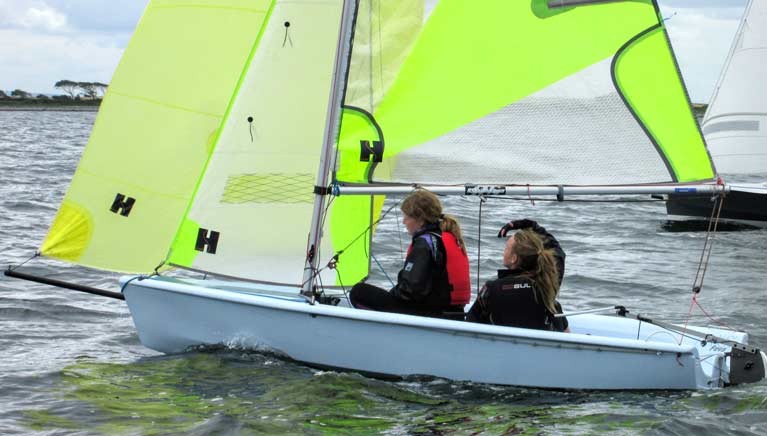 RS Fevas were competing for Western championships honours
RS Fevas were competing for Western championships honours
It was a grey start to day one of the RS 200 nationals. Cloud and light rain created an authentic scene for the west of Ireland. The sailors arrived early to rig their boats. With a short briefing at 10:30am, the competitors were ready to sail.
A twelve-knot breeze blew down the bay. With a long course set, racing was underway. Taking the win for race one was Conor and Jack Galligan from Greystones SC. Race two was won by Chris Bateman and Atlee Kohl (MBSC/RCYC). With the wind dying slowly, racing became tricky. Jocelyn Hill and Katie Kane from Co. Antrim SC showed good speed, winning the final race of the day. Conor and Jack Galligan sailed well, giving them an overnight lead after day one.
Another dull morning greeted the fleet for day two. The RS 200’s were joined by the 400’s and Fevas, who arrived early to make it in time for the 11 am start. Howling winds blew across the bay, with winds in excess of 25 knots. A one-hour postponement later, and racing was called off for the day.
Day three dawned with much more promising views. A steady 10-12 knot breeze had filled in overnight and racing was sure to go ahead. The competitors had a quick briefing and in no time were on the water. Four races were scheduled, and conditions were perfect.
The RS 400 fleet started first, with 11 boats lining up on the start. Barry McCartin and Andrew Penney (CSBC/RstGYC) took first place in race one of their westerns. The RS 200 fleet started second, and as points were tight the start line was a competitive place. Taking another win was the Galligans. In the Feva fleet, two boats joined the other RS sailors to race in their Westerns.
Race two saw Barry McCartin and Andrew Penney take first place. This was the second of four wins in total (a clean sweep). In the RS 200 fleet, Adam Power and Jack Young (Previous RS 200 nationals winners) took the win, having sailed exceptionally well around the course.
Race three and four were got underway quickly, to finish racing within the time limit. In the RS 400’s McCartin and Penney got two more wins. In the RS 200 fleet, Chris Bateman and Atlee Kohl also clinched two wins, in very tight racing.
The sailors returned to shore, tired but having had a solid day sailing. A few protests later, and prizegiving was underway. In the RS 400 fleet, Barry McCartin and Andrew Penney took first place, winning the Western championships. In second was Chris and Niall Eames (SLYC). In third place was Govan Berridge and David Coleman (Killaloe SC).
For the RS 200 Nationals, it had been tight racing with high competition. Winning the Championships was Chris Bateman crewed by Atlee Kohl (MBSC/RCYC). In second place (a point below) was Conor and Jack Galligan (Greystones SC). In third place was Frank O’Rourke and Emma Hynes (Greystones SC), having sailed fast, and holding a very consistent series.
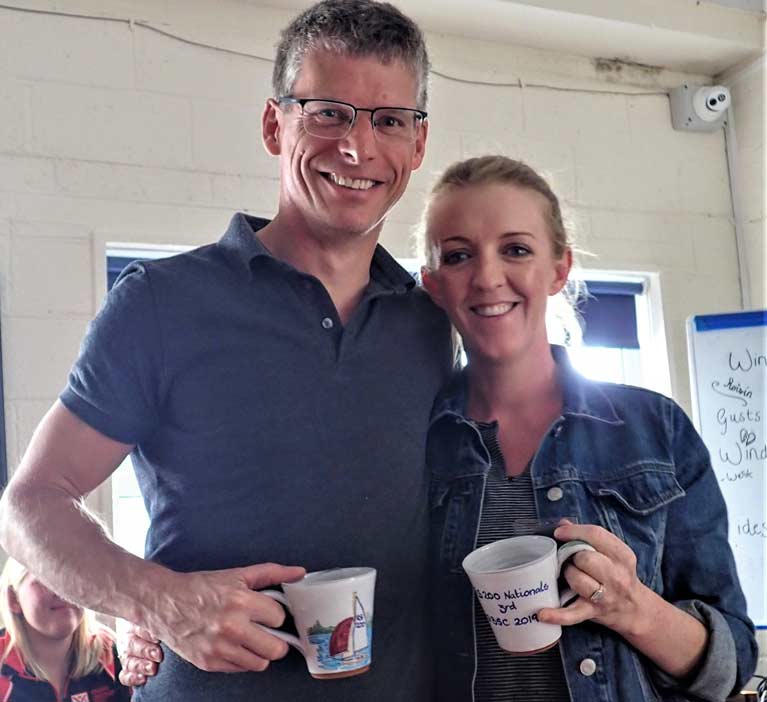 Frank O'Rourke and Emma Hynes, 3rd place RS 200 Nationals
Frank O'Rourke and Emma Hynes, 3rd place RS 200 Nationals
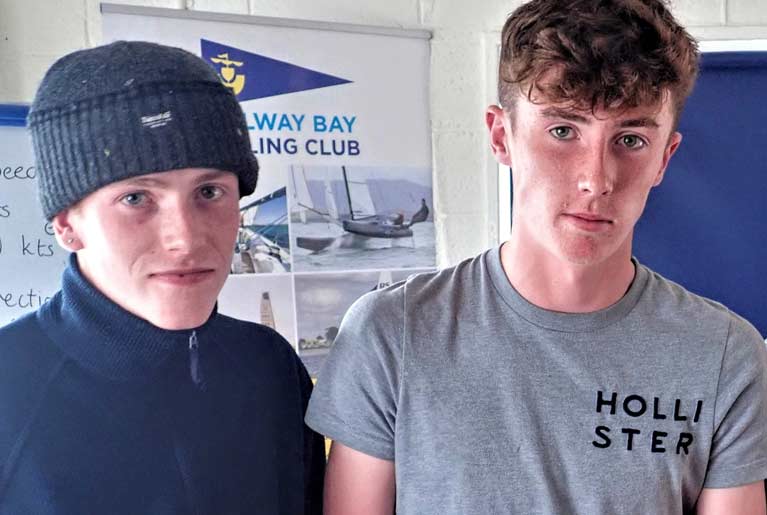 The Galligan's, 2nd RS 200 nationals
The Galligan's, 2nd RS 200 nationals
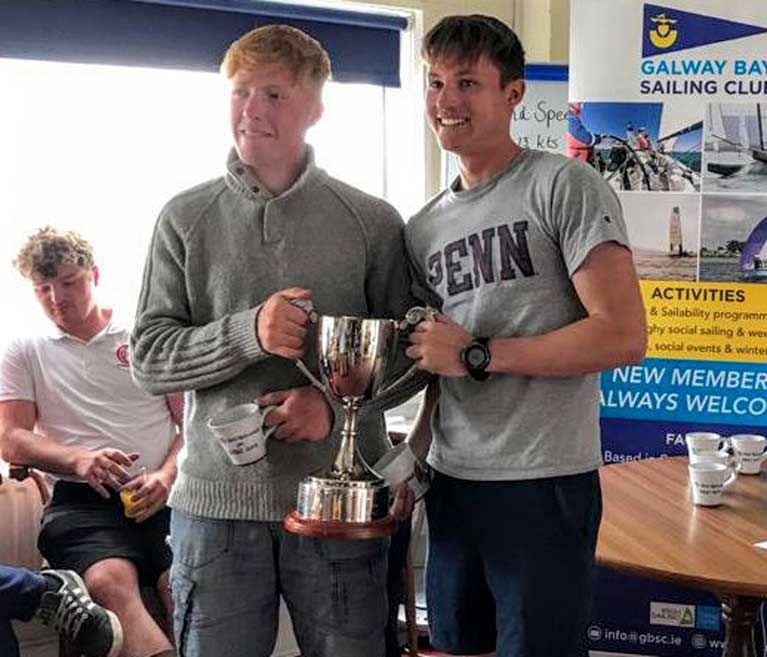 Chris Bateman crewed by Atlee Kohl, 1rst RS 200 nationals
Chris Bateman crewed by Atlee Kohl, 1rst RS 200 nationals




























